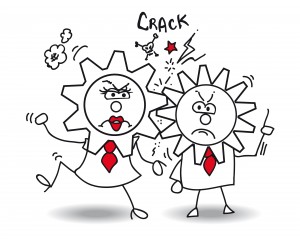
by Brie Barker | Leadership Development
Trust is the lifeblood of effective, enduring leadership.
Want your employees to trust you enough to follow you just about anywhere?
Here are 4 things you can do to earn trust as a leader.
Read the following list while embracing two important concepts:
» Trust is based on the emotional connections between people, not on the connections between people on an org chart.
» Heed the good advice of Aristotle that any good novelist, playwright or screenwriter does: character is action.
1. Show Your Face:
You know the show Undercover Boss? Strive to never be a viable candidate for that show. You want to be the boss that every one of your employees will take one look at in that disguise of yours and say, “Hey, nice try! I know who you are!”
But it needs to go beyond that.

©DonkeyHotey
Don’t be that holy visitor from the top floor who walks briskly through the cube farm and bellows Pythonesque pomposities like, “Morning, Johnson! Keep up the good work now!”
You need to know who they are. You need to demonstrate you care about them by taking an interest in who they are and what their day-to-day working reality is all about: what the value they bring to the organization is, what their challenges and suggestions are.
If you’re leading such a big group of people that the goal of knowing all of them is just not feasible, you should still schedule a regular time in your calendar to make the rounds and have some meaningful face time with as many as you can. This is not an all or nothing scenario.
Trust is based on relationship. The person who is trusted never has to say, “Trust me,” and will never hear the reply, “Trust you? I don’t even know you.”
2. Put Your Employees’ Interests Above Your Own:
If you poll your employees about whether or not they trust you, many of them will filter this question as, “Do I trust them to do what’s best for me?” Or, in other words, do they think you’ve got their back; that, when the chips are down and things get tough, do they trust that you’ll put their interests before your own personal interests.

For a deeper exploration of this, delve into Simon Sinek‘s latest book, Leaders Eat Last.
For a more concise affirmation, trust Spock’s statement, “The needs of the many outweigh the needs of the few – or the one.”
3. Lead by Example:
Think about any movie you’ve ever seen that involves an armed battle. Now think about the leaders of each opposing side. Which side almost always emerges victorious? The side whose soldiers have the most trust in their leader — the side who’s leader joins them in the actual battle, not the one who commands from the safety of the rear.

If you’re calling on your employees to sacrifice for the good of the organization, you need to sacrifice, too. You need to be right there in the trenches with them, sleeves rolled up, showing them you believe in the cause you’re asking them to fight for.
4. Trust the People You’re Leading
Another key factor in earning the trust of your employees is demonstrating that you trust them.
I’m not talking about throwing people into the deep end, just assuming they can swim to the other side, and then saying, “Hey, I gave you a chance to prove yourself and you blew it. From now on you don’t leave the shallow end unless I’m there to watch you.” The only people who should be micro-managed are those who respond well to being micro-managed.
Rather, give your employee a goal to accomplish, ask them to devise and show you their plan to achieve it, offer any necessary guidance, and then get out of the way and empower them with 100% trust to accomplish it. Based on the results, adjust the amount of active support you need to give them. You’ll soon discover what their full abilities are: if they meet or surpass the expected standard, great, you know you can trust them to get the job done; if they don’t meet the expected standard, you can collaborate on a learning and development plan to address the areas of needed improvement. Do this and they’ll trust you have their best interests at heart.
 “The best way to find out if you can
“The best way to find out if you can
trust somebody — is to trust them.”
— Ernest Hemingway
Have a productive and enjoyable day.

by Brie Barker | Leadership Development
If you lead a team of people, be they senior executives, managers or support staff, you might be unknowingly asking stacked questions. The end result is that you’re not likely to get the information that led you to ask the questions in the first place … and you might not even realize it.
There have been a lot of courtroom drama series on TV over the past few years that I’ve enjoyed, such as The Good Wife, Boston Legal and Suits. One scenario I’m sure everyone’s seen is the lawyer who’s pummelling a witness on the courtroom stand with a relentless, continual barrage of questions. It’s a technique that usually ends up with the witness getting rattled and confused and either being discredited or, in fine TV tradition, cracking under the pressure and confessing to the crime.
Well, listen closely to people at work when they’re asking questions and, chances are, you’ll hear many of them asking stacked questions, i.e. ones that come one right after another with no space in between that gives the other person a chance to answer.
Unlike the TV lawyer, it’s highly likely that your co-worker has no idea they’re doing this. The questions may not have any hard edge to them either, rather, the person is just trying to get some helpful information from the other party.
Here’s the problem … when you ask stacked questions, the person on the receiving end is likely to either:
1. Only answer the last question that is asked,
2. Only answer the question they feel most comfortable answering,
3. Provide an answer that tries to address all the questions but doesn’t really answer any of them.
Why does this happen? Let’s consider the person on the receiving end of the questions first:

It’s going to be rare that the person on the receiving end is 100% present, in a perfect Zen-like state of mind where they are listening to you without distraction, ego or filters. Like most of us, they’re probably going to have a lot of other things going on in their mind, be consciously or non-consciously thinking about their own interests (hello, Ego), and be hearing the questions through a set of filters built on the historical, emotional landscape of the relationship.
Expecting the person to fully track, process and respond to all of the stacked questions is unrealistic. So, the person just tries their best.
Now let’s consider the person who’s hearing the response to their stacked questions: their ability to be 100% present to the other person is likely just as compromised as their’s is.
So, here’s what the average person’s brain will do in this situation: if the brain registers an answer that corresponds to one of the questions that was asked, it closes the loop, i.e. a question was asked and a relevant answer was received. Done! Perhaps the person will probe deeper to get more information on that particular question, but their brain is not likely to take them back to address the other questions. In other words, because the brain is just trying to keep up with all of its thoughts — or “mind noise” — the brain just lumps all of the questions they asked as “the question” and that the questioned answered meant “all questions answered.”
At best, the person will later realize that they didn’t get all the information they were looking for and then go back to the other person to try again. It’s like going to put on a clean shirt and only then realizing that one of the stains you meant to get out was still there. It’s not the laundry machine’s fault that you forgot to take your time to ensure you individually pre-treated all of the stains you wanted taken care of, right? (Sigh) Rinse; repeat.
At worst, the person will never realize they didn’t get an answer to the other questions and forget about them, perhaps until it’s too late and it causes a problem — having the CEO point out in the senior staff meeting that you’ve got a mustard stain the size of Wisconsin on your shirt will do nothing to help your career.
So … what should you do?
Become as deliberate and practiced in asking one question at a time and giving space for as full a response as the hotshot TV lawyer is in using stacked questions as a cross-examination technique … unless, of course, you’re trying to get someone to confess to stealing your sushi from the lunchroom fridge.
Have a productive and enjoyable day.

by Brie Barker | Leadership Development
We all know the adage, “There is no ‘I’ in ‘Team’.” Actually, there are times when the ‘I’ needs to be embraced in order to get the most out of the team.
I was working with a client this past fall — we’ll call her Josée — who felt at a loss on how to better engage one of her staff members — we’ll call her Anita.
Josée manages a team of about 15 people. Josée’s a very energetic and social person and she places a great value on teamwork. She believes team productivity comes from working collaboratively and spending quality social time together. Josée said that every one of her staff members embraced her approach; every one, that is, except Anita.
Josée said that Anita had never really fit in with the rest of the group. She actively resisted working collaboratively, preferring to work on her own, and her going out with the gang for lunch or after work happened only once in a blue moon. And, lately, these things had intensified to a point where Josée felt it was having an increasingly negative effect on the whole team, dragging down morale, with gossip eating away at productivity.
Josée said she tried everything she could think of to get Anita more engaged but nothing had been working.
What Josée hadn’t considered, was that there is, indeed, a place for “I” in “Team”.
Without intent or malice, Josée was actually making the whole situation worse.
Anita was only a problem because Josée was judging her through her own filter and not honouring the way that Anita is naturally wired:
⇒ Josée prefers working with people, Anita prefers working alone.
⇒ Josée is an open book regarding her personal life, Anita prefers privacy.
⇒ Josée likes to socialize after hours, Anita just wants to get home to her family.
The more Josée pressed Anita to open up, socialize and work in active collaboration with her colleagues, the more Anita withdrew, the more the gossip kicked in and, as was happening, the more it was effecting Anita’s ability to do her job well. If Josée didn’t change her ways, it probably wouldn’t been long before Anita just quit.
To be an effective manager, one has to recognize and accept the way people are wired and find a way to honour their strengths and put them in a role that plays to those strengths as much as possible.
Josée needs to:
⇒ respect Anita’s desire for privacy,
⇒ find as many ways as possible for Anita to work independently, and
⇒ publicly value Anita’s output as a positive contribution to the team.

When it’s leveraged in positive and productive ways,
there certainly is a valuable place for “I” in “Team.”
Have a productive and enjoyable day.

by Brie Barker | Leadership Development
All managers are human … and managers need to be able to reconcile their human values with their managerial responsibilities. Sometimes, that’s easier said than done.
Recently, I was helping a client — we’ll call him Jack — who is less than a year into his role as a senior manager of a department that he was new to. Jack has been having a really tough time figuring out how to deal with one of the staff members he inherited — we’ll call him Stan.
Stan is in his late 60s and has been in the department for forever and Jack told me that he’s one of the sweetest, nicest guys you’ll ever meet. However, Jack also said that Stan’s productivity level is only about 20%, that his memory runs hot and cold, that he often appears unkempt and that it’s become clear that the rest of the staff were always trying to cover for him. Stan didn’t even appear to be aware of these things.
So, Jack did some digging. What he found out was, prior to a couple of years ago, Stan was the go-to guy for his expertise and was highly productive — pretty much the department’s superstar. Jack wondered, what on earth had happened that created such a dramatic change in this man?
It turns out that Stan had been the victim of an assault that had left him with significant head injuries. Such a tragic story.
Now Jack was facing a dilemma. From a human standpoint, Jack felt a great deal of sympathy for Stan and didn’t want to make this poor guy’s life any harder. From a managerial perspective, Jack knew that, for the good of the department and the organization, the productivity issue had to be resolved. Jack said the problem would resolve itself if Stan just retired. However, Stan had made it clear that he had no intention of retiring. Having difficulty reconciling these two things, Jack recognized he was just avoiding Stan altogether.
Jack had fallen into a mindset that’s easy to fall into when facing a difficult dilemma — the “either/or” mindset.
The managers and leaders who cultivate the ability to see past this restrictive mindset are able to be more effective.

When it comes to workplace relationships, the best managers and leaders are able to adapt their communication style not only depending upon the individual they’re communicating with, but also from moment to moment whilst communicating with them.
For example, if Jack wants Stan to be more productive AND wants to support him and keep him in his position, Jack needs to do two things:
1. Be crystal clear and direct with Stan about his performance level: where it’s at, where it needs to be and why, and what will happen if things don’t change.
2. Then, once the above message is fully received, switch to more of an affiliative, coaching approach to get Stan’s productivity up as high as it can go, given the reality of his health situation.
That first step is not within Jack’s comfort zone, within his natural way of being; while the second step is — that’s why Jack’s been avoiding the situation.
What does Stan need to hear in order to get the message?
Remember, Stan used to be the expert, the go-to guy, so you can imagine how difficult it might be for him to swallow his pride and openly acknowledge that his performance level is unsatisfactory. So Jack can likely expect some resistance and needs to know what can help him get through to Stan.
Jack has to adapt how he communicates information based on how Stan processes information.

For example, Stan’s job is very technical and requires precise thinking and he tends to need data before he’s convinced of anything. Jack needs to be prepared to leverage this, to show Stan empirical evidence to prove his lack of performance and why it’s critical it improves.
Once Stan can admit to the reality of the situation, Jack can swing back into his comfort zone of supporting Stan and collaborate on an action plan to get Stan up to his maximum performance level.
What happens next?
Well, if Stan’s productivity level can rise to an acceptable level, then all will be good in the world.
However, if Stan’s current abilities just can’t meet the demands of the job, then Jack needs to honour the organization and take the appropriate steps to let Stan go … and that will be hard for Jack. But that’s leadership.
Have a productive and enjoyable day.
by Brie Barker | Leadership Development
Introducing Guest Blogger Judy Kiar:
Judy Kiar is an Ottawa therapist with over thirty years experience who, for the past fifteen years, has been serving individuals, couples and families through her private practice, Judy Kiar Counselling.
Judy’s guiding philosophy is so in step with mine that I only have to change two words of it to make it reflect my work specifically (my replacement words are in green):
“Life/Work is a complicated endeavour full of challenges as well as joys. It is a sign of good mental/professional health to recognize when things aren’t going well and to seek help to improve them.”
In her practice, Judy has seen the terribly destructive consequences that a dysfunctional workplace relationship can have on someone’s life. I hope you appreciate what she has to say; I know I do.
Have a good read and I wish you an enjoyable and productive day.
Brie
The Workplace Relationship Dance
by Judy Kiar
 Relationships come with most workplaces. Most of the time we don’t get to choose whom we work with. We end up spending more waking hours with some colleagues than with our families and friends. Many times these relationships are governed by the hierarchical structure of the work place. Sometimes they are affected by competition for advancement. It’s inevitable that irritations or conflicts will arise from time to time. Because our work-lives are crucial to our financial and professional success, problems within them can feel life threatening. It’s important to minimize interpersonal conflict and learn to maintain healthy working relationships.
Relationships come with most workplaces. Most of the time we don’t get to choose whom we work with. We end up spending more waking hours with some colleagues than with our families and friends. Many times these relationships are governed by the hierarchical structure of the work place. Sometimes they are affected by competition for advancement. It’s inevitable that irritations or conflicts will arise from time to time. Because our work-lives are crucial to our financial and professional success, problems within them can feel life threatening. It’s important to minimize interpersonal conflict and learn to maintain healthy working relationships.
It seems to be human nature to want to blame the other person and wish they would be more like us. The truth though, is that you cannot change another person. You may be able to influence or encourage them, but ultimately, the only person you can change or control is you. Ironically, you are probably the most powerful tool you have in improving your relationships with other people.
Some of the best books written on building healthy interpersonal relationships, in my opinion, are Harriet Lerner’s Dance of Intimacy and Dance of Anger. Lerner conceptualizes relationship interactions as dances. We get into habits of acting and reacting in certain ways with each other. Some of these work well and some don’t. Often we get caught up in the dance and don’t really break it down to figure out all the steps that are making it turn out the way it is.
In the work place, we can become very aware of what other people are doing or not doing. If we are not happy with the way another person acts its easy to re-act in ways that show our disapproval, without actually communicating the problem to the other person. Shooting dagger-glances at a colleague, who has a habit of whistling while he works, just sets in motion a non-verbal communication, which might have no basis in reality. Whistler whistles, you glare, whistler assumes you don’t like him and glares back, this confirms your negative view of him and his of you. Before you know it you are no longer greeting each other in the hallways. You spend time and energy complaining about each other with coworkers and friends. The workplace has become toxic and our stress levels are through the roof!
The first step is to look at the dance as a whole and then break it down into its steps. Look at what you did and what the other person did. Think about how you felt along the way. What motivated you to act the way you did? Were you taking things personally that perhaps were not about you? Try to imagine what message you were sending with your actions. Ask yourself if you feel good about your part in the dance. Could you have been more direct, more empathetic, or more reasonable? Were there other things you could have done? Did other factors or feelings influence your behaviour?
The next step is to think about how you would prefer the interaction to go. You may feel overly responsible or overly criticized. What could you do to get that balance more in line with how you want to feel? What might happen if you look after your own feelings in the dance and change a few of your own, automatic steps?
Try not to take things personally. If there is something you can ask the other person to change, then ask in a polite, straightforward and respectful way. If you just don’t like them, try to cultivate an attitude of acceptance. Don’t make assumptions about them and don’t harbor grudges. Don’t waste energy dwelling on what you don’t like. Be on the look out for things that you do. You want to cultivate a live-and-let-live attitude wherever possible. The more you act in a positive, professional and friendly manner the more likely it is that you will be repaid in kind.
Sometimes, people are really resistive to change and will try really hard to get you to go back to an old familiar dance – even if it does not serve them well. If you hold firm and resist the urge to get back into those old steps, you are almost guaranteed to change the whole dance – one way or another. You have that power.
Get in the habit of looking at your own steps in all your relationships and see where you might like to try some new moves. Nobody gets a new dance right the first time. It’s going to take practice. Being good dance partners means being in-tune with each other and responding appropriately. Try to remember that perfecting the moves together is the only way to stop getting your toes stepped on when doing the workplace relationship dance.
You can reach Judy Kiar at ju**@ju******.com, 613-521-8800, www.judykiar.com.

“The best way to find out if you can













